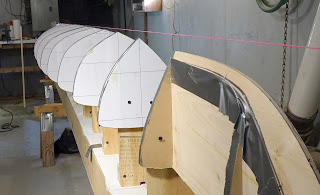I had been thinking, for a long time, of building a kayak intended for sale only. Instead, I built the SLT. Now I finally have the two kayaks I want to use: The Big One, for more "serious" conditions, and The Small, "grab & go" one for short trips, groups, etc.
Kayak Foundry. My intention was to design a flatwater-cruising boat, with a long waterline and low rocker. I'm still somewhat "locked into" the KF "rules", but I'm trying to be slightly more intuitive. I posted a message on Facebook's Kayak Building page, asking the simple question of "How much should I ask for a new, hand-built kayak?" I got the usual string of Message Board Responses, with many putting their own interpretation on the question, and a few helpful responses. Some seemed to read the question as "how to I make a fortune selling kayaks?", "how do I make a living selling kayaks?", or "is it worth it for me to sell a kayak?". Nick linked to an article on his website which is seemingly designed to discourage anyone else from trying to sell kayaks, and in about the next breath encouraged another guy to try raising his prices! I don't know as if anyone actually gave me a plausible $.
The wooden kayaks on EBay are priced around $4000. I'm watching the listings to see if they actually sell.
I'm going to build it. I's going to be a little stressful, having to pay much attention to detail.
11-14
I also asked the folks on Kayak Foundry what they thought, and got very technical answers, including a very thorough article by N. Schade about Stability. It answered my question of what creates the "catch" of Secondary Stability. I guess it depends on who you ask-Jay Babina (artist): "Anything goes! Have fun!" Rob Macks (craftsman): "Kayak Foundry is a program adapted from a program designed for larger boats! You can't use those numbers on kayaks!" Nick Schade (engineer): Two page article with charts and math.
In the end, I decide on something and do it, both in building and and trying to sell it.

















































